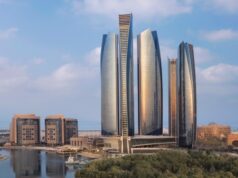MADISON, WISC.—Upon entering the Arbor House—an Environmental Inn, you may want to watch where you step. The door mat is made from recycled truck tires. That is just one of the many ways the eight-room inn lives up to its name. Many of the items found in this historic Madison property were added or kept with the environment in mind.
“Arbor House’s mission is to provide the art of hospitality within a model for urban ecology,” the inn’s website says. “Our goal is the wise use of resources and providing guests with an unparalleled combination of natural design, features, fabrics, amenities and surroundings, while providing opportunities for recreation and learning more about urban ecology.”
John and Cathie Imes, the inn’s owners, knew they had a gem on their hands when they bought the original 1840s Plough Inn landmark in 1994. They spent $150,000 restoring the old bed and breakfast property. In 1996 they completed construction on an annex, which added three guest suites, a breakfast room and owner’s quarters.
From the beginning, the couple wanted to be as environmentally efficient as possible. The original building was improved with triple-glazed windows. A high-efficiency gas boiler is used to heat water for heating but no mechanical air conditioning is present. Instead, passive cooling during the summer is achieved through window shading, trees, thermally massive walls, and ceiling fans. Low-flow showerheads and toilets are included in each guest suite and floor tile used in the inn is made from up to 85 percent post-consumer glass. A whole-house fan circulation system is used to keep the air fresh.

For the annex, lumber from regional, sustainably harvested sources was used where possible. No toxic treated lumber was used for decks and posts. Insulation is recycled cellulose. Interior paint made from plant-based products was used throughout the inn. Products prone to outgassing were avoided. The circuit design and night shutoff feature at all sleeping areas reduces human exposure to electromagnetic fields.
Outside the inn, the owners have planted extensive gardens, making exclusive use of native, drought-tolerant plant species. Most of the site’s storm water is dispersed on the site, not funneled by downspouts, nor directed to the storm sewer.
Owners Buy Local When Possible
As a bed and breakfast type of inn, the owners serve up a hearty breakfast to guests each morning. Breakfast ingredients are bought from local producers when possible. Milk is delivered in old-fashioned glass bottles. These are returned to the dairy for reuse.
“Buying local is a big part of what we do,” Cathie Imes says.
Appliances are Energy Star rated. In each bathroom, Aveda amenities are featured in refillable containers—not throwaway bottles. Natural cleaning products from a Minnesota company called Safe and Clean are used throughout the inn. Organic towels, sheets, bathrobes and mattresses are included in each guest suite. Guests may even order an organic mattress for home use. If guests wish to explore the Madison area, they are given free public transportation tickets.
For the owners, the property is an ideal marriage of ideas and talents. John worked for Hyatt for seven years and has a four-year degree in environmental science. Cathie has an MBA and a background in marketing. Their work together has produced many accolades. The inn has been featured in many magazines and newspapers and has won awards including the Wisconsin’s Governor’s Award for Waste Reduction.
“We have gotten a lot of attention for our efforts,” Cathie says.
Marketing itself as a green inn certainly has worked well for the Imes family. From 10 to 15 percent of the 4,000 guests who stay at the property each year do so because of the property’s emphasis on responsible operations. With all of the success they have had, Cathie wonders why other inns have not taken the same business approach.
“We should not still be pioneers in this area,” she says. “It takes a lot of perseverance to do what we do but it is not rocket science.”
Cathie has some advice for those interested in opening an environmental inn.
“Make sure the choices you make come from something deep inside you,” she says. “It also has to make good economic sense. Price it right and make sure you market it right. We have done well because we have married our environmental interest with our strong business sense. There has to be a good business plan.”
Go to Arbor House, an Environmental Inn.
Glenn Hasek can be reached at editor@greenlodgingnews.com.









